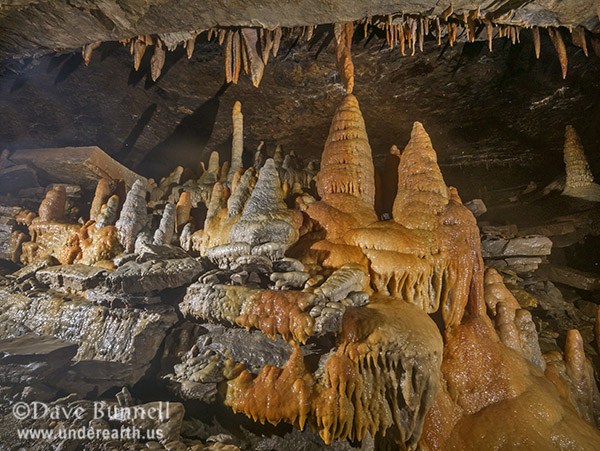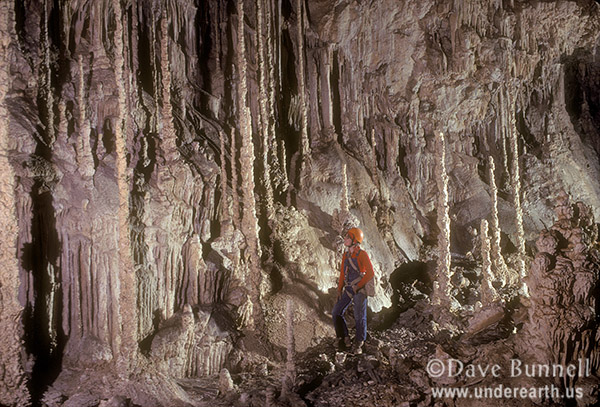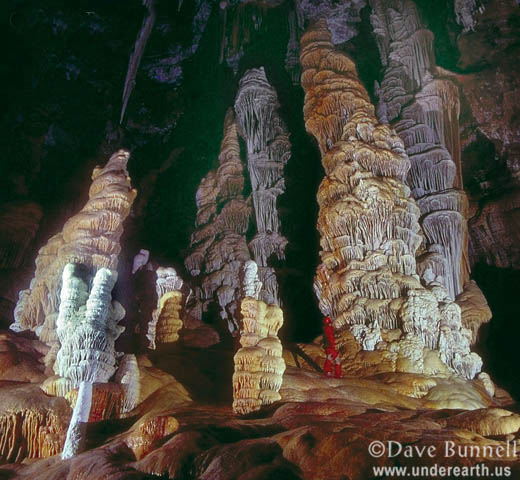
|
Stalagmites, some of the most familiar cave formations, are best known as upward-growing, massive calcite mounds deposited
from drip water. Calcite stalagmites are the focus of this page, but even so, their variety is barely touched upon
here. Be sure to drop by the Splattermite Chamber and visit
some more of my personal favorites in the Wide World of Calcite Stalagmites.
As with all speleothems, stalagmites are identified not by their mineral composition, but by their outward form and internal structure. Thus, cavers also refer to aragonite and gypsum stalagmites, when we are lucky enough to come across them. A very impressive aragonite stal can be seen in the Raft Cone Branch of the Virtual Cave. The growth mechanism is the same as for flowstone: meteoric water that finds its way down into the cave from the surface tends to become slightly acidic, picking up carbon dioxide, especially if traveling through vegetation and soil. This helps it dissolve a bit of the limestone it is passing through. When it enters the cave, some of this carbon dioxide naturally offgasses into the air, at which time the water is unable to hold as much dissolved limestone in solution. It precipitates out as a mineral form, calcite, which deposits in crystalline form. As can be seen in the intensely corroded specimen of the top photo, stalagmites are built up from many successive growth layers. As can't be seen in the photo, each layer is made up of tiny, elongate calcite crystals oriented roughly perpendicular to the growing surface. If drip water evaporates from the stalagmite surface, layers of minute aragonite crystals may also develop. Darkly stained layers attest to the episodic influx of impurities, usually organics. Stalagmites take on a variety of forms, from typical rounded top shapes (second photo) to tall, spindly "broomsticks" (third photo) to ornate, multi-tiered towers (fourth photo). Shape is determined largely by drip rate, ceiling height, cave atmosphere conditions, and the carbonate chemistry of the drip water solution. Broomsticks, for instance, form where deposition of calcite occurs rapidly, before drip water has a chance to dribble down along the sides of the stalagmite. Oddly, these conditions occur both in the tropics, where high carbon dioxide levels inherited from overlying soils cause rapid degassing and depostition, and in arid regions, where deposition can be accelerated by evaporation. The towers of photo #4 have formed beneath a high ceiling, but here receive many rapid drips since they immediately underlie a surface canyon. Overhanging tiers are again the result of drip splash. Many stalagmites can be absolutely dated by virtue of naturally occuring radioactive isotopes which substitute for calcium as the formation is deposited. The original ("parent") isotopes decay to "daughter" isotopes at a predictable rate, so that the ratio of the two allows calculation of the time since deposition. The stalagmite's natural clock has thus allowed dating of associated paleontological and achaeological finds, as well as records of past climate registered in the stalagmites themselves. UPDATE
|
![]()




![]()
| Back to: | |
 |
Created: June 19, 1995 Last Updated: Dec. 14, 2019 Authors: Djuna Bewley and Dave Bunnell |